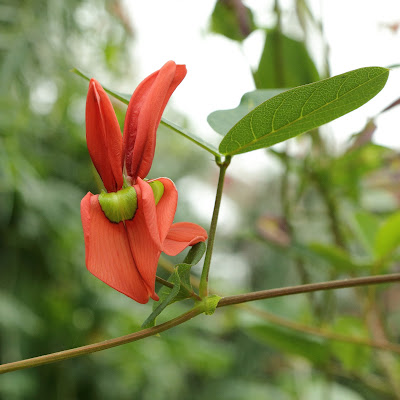Plant of the day is: Kennedia beckxiana or Cape Arid Kennedia
Back to Australia we go. I've got a lot of Australian plants coming up, especially Fabaceae, so this is my opportunity to learn more and share it in the process. Enjoy.
Taxonomy, etc.: Not going to go into too much depth here really. Clearly a member of the Fabaceae family and in the Phaseoleae tribe. Even if the floral parts are a little elongated, they still look pretty pea-like. And that trifoliate leaf and fruit are VERY leguminous. Cracks me up a bit that leguminous doesn't get flagged but trifoliate does. I hardly spell check any more due to the lack of botanical terms in the check. If you see something goofy in here (more than usual) that is why! Anyways, theplantlist.org lists 15 accepted species and a few more unresolved or still in review. A pretty small genus and all of them native to Australia. They are evergreen climbing plants with woody stems, usually with trifoliate leaves. The genus is named after Étienne Pierre Ventenat after John Kennedy. You remember Kennedy right? The Vineyard at Hammersmith, London? James Lee? Again, small world in botany sometimes, can't avoid some of these connections. The specific epithet honors Gustav Beckx, a 19th century Belgian consulate General in Australia. Kennedia glabrata is listed as vulnerable under Australia's EPBC Act. I recommend a peep at Kennedia nigricans as well, as it has stunning very dark purple-black flowers with yellow on the reflexed keels.
Looks like a legume to me!
Description: As mentioned, an evergreen perennial woody vine that reaches about 3 m in height give or take a bit. Leaves are alternate, trifoliate, ovate, and about 6 cm long. Flowers are also about 6 cm long and appear in late Spring or early summer (which is September-December in Australia...you lucky folks right now). Flowers are orange-red and are...the largest in the genus!!! Now that is a fun fact! Well, it is for me anyways. The flowers also have that showy lime-green central spot at the base of the reflexed keel petal (see below...I feel like it's telling me to "peace out"). Oh, I haven't read this but I'm pretty sure it's a twining vine. That can be important if growing. Quite important.
Habitat/culture: The species comes from the Cape Arid and Israelite Bay region of Western Australia (east of Esperance) where it grows on granitic sand. Prefers full sun and a well drained soil but can without stand a little bit of shade and a decent range of soil types. Is actually a little bit frost tolerant, can handle temps a few degrees below freezing but not much. A light to medium and brief freeze. There is actually a somewhat available cultivar 'Flamboyant' available if you look for it. Very drought tolerant when established and a nice niche in the vine world as it is not too large or aggressive of a vine. In warmer climates I reckon it would make a great addition to fences. In colder climates, will have to be overwintered for sure but may grow well in a decent sized pot with trellis. I should imagine it would be a thrip magnet (as I tend to see most legumes bring them in like hotcakes in a greenhouse).
That's all folks. Enjoy.



No comments:
Post a Comment